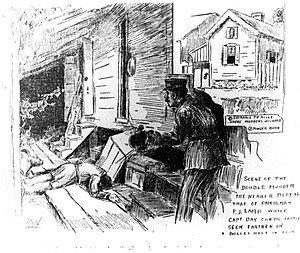Our website is made possible by displaying online advertisements to our visitors.
Please consider supporting us by disabling your ad blocker.
Robert Charles riots
| Robert Charles riots | ||||
|---|---|---|---|---|
 Sketch of the scene at Robert Charles' residence on the 2000 block of Fourth Street. Body in the middle is Patrolman Lamb; the body is the left background is that of Captain Day | ||||
| Date | July 23 – July 28, 1900 | |||
| Location | New Orleans, Louisiana, United States | |||
| Caused by | White reaction to killing of policemen | |||
| Goals | Suppression of African Americans; revenge | |||
| Methods | Rioting, looting, assault, arson, property damage, firefights, murder | |||
| Parties | ||||
| ||||
| Lead figures | ||||
| Casualties | ||||
| Death(s) | 28[1] | |||
| Injuries | 61 (mostly blacks) | |||
| Arrested | 19 (10 blacks and 9 whites indicted for murder) | |||
| Part of a series on the |
| Nadir of American race relations |
|---|
 |
The Robert Charles riots of July 24–27, 1900 in New Orleans, Louisiana were sparked after African-American laborer Robert Charles fatally shot a white police officer during an altercation and escaped arrest. A large manhunt for him ensued, and a white mob started rioting, attacking blacks throughout the city. The manhunt for Charles began on Monday, July 23, 1900, and ended when Charles was killed on Friday, July 27, shot by a special police volunteer. The mob shot him hundreds more times, and beat the body.
White rioting continued, with several blacks killed after Charles had died. A total of 28 people were killed in the riots, including Charles. More than 50 people were wounded in the riots, including at least 11 who had to be hospitalized. Blacks made up most of the fatalities and casualties.
Robert Charles (b. circa 1865) had come to New Orleans from Mississippi. He was a self-educated activist for civil rights. He believed in self-defense for the African-American community and encouraged Afro Americans to move to Liberia to escape racial discrimination and violence.[2]
- ^ Joel Williamson, The Crucible of Race: Black-White Relations in the American South Since Emancipation (New York: Oxford University Press, 1984)
- ^ "Robert Charles Riots (1900)", Black Past
Previous Page Next Page


